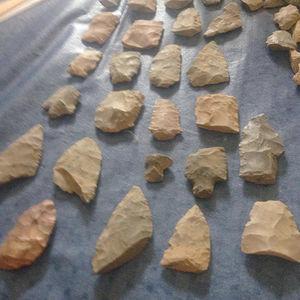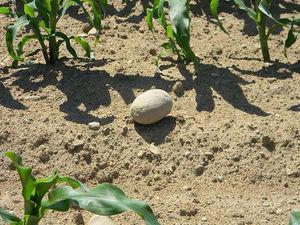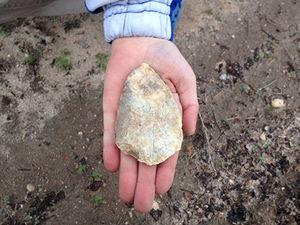Foss Farrar
Source - http://www.winfieldcourier.com/news/article_2ab0935e-0678-11e5-9238-9b0332ae7e77.html
 The site where most of the these artifacts are being found is known as the Greenway Trail, Bypass Trail, or Kneebler Pond Area in Ark City. (Arkansas City's Ancient Indian City "Etzanoa)
The site where most of the these artifacts are being found is known as the Greenway Trail, Bypass Trail, or Kneebler Pond Area in Ark City. (Arkansas City's Ancient Indian City "Etzanoa)
An archaeology team that will perform a five-day study next month in the Arkansas City area will do very little digging, the archaeologist who will lead the study told a group of landowners and community representatives last week.
Instead, the team will use non-intrusive remote sensing equipment to provide images of what’s beneath the ground along the broad swaths of land they plan to survey.
And the team will use a mobile technology lab to examine freshly excavated artifacts that are found in the areas where landowner permission has been given.
“My primary purpose is to prove what I already know,” said Don Blakeslee, the Wichita State University archaeologist leading the project, which will be conducted June 1-5. “We’ll be doing a little bit of digging — a very little bit.”
Blakeslee, an expert on the Plains Indians, said recent research strongly points to the eastern Arkansas City area as the “Great Settlement” discovered in 1601 by Spanish explorers during an expedition to New Mexico, Texas, Oklahoma and Kansas.
 The Spanish contact in 1601 by Governor Onate of New Mexico documented 2,000 houses of this type of grass thatched house. The average family size living in each house was 10. Thus, making this the second largest single prehistoric Indian City documented in the United States. The houses were usually 20 ft. in diameter and as described, 2 Spanish lances tall [16 ft.]. Governor Onate referred to the city in his journal as "Etzanoa"
The Spanish contact in 1601 by Governor Onate of New Mexico documented 2,000 houses of this type of grass thatched house. The average family size living in each house was 10. Thus, making this the second largest single prehistoric Indian City documented in the United States. The houses were usually 20 ft. in diameter and as described, 2 Spanish lances tall [16 ft.]. Governor Onate referred to the city in his journal as "Etzanoa"
About 20,000 Native Americans — ancestors of the Wichita Indians — lived in the town that they called Etzanoa. It was the second-largest Native American settlement in pre-Columbian times, he said.
Blakeslee said he wants to learn more about how they lived and worked during the period they were here, between 1450 and 1708.
The digging will occur only on city-owned land and a plowed field. “That property is already set aside,” he said.
He added that the owners have given him permission to dig on their land.
Blakeslee and Bob Hoard, the state archaeologist of Kansas, addressed about half a dozen landowners and 24 members of an archaeological project steering committee at a meeting May 13 at Cherokee Strip Land Rush Museum.
The committee includes representatives of many of the key organizations in Ark City, noted Hap McLeod, who leads the group.
 These fist-sized rocks were heated in fires and then transferred into hide-lined pits or other containers to boil water or cook meat
These fist-sized rocks were heated in fires and then transferred into hide-lined pits or other containers to boil water or cook meat
The two archaeologists described how the project would be carried out. They also answered questions from landowners about their property rights.
 A single large arrowhead found at the historical site in Ark City.
A single large arrowhead found at the historical site in Ark City.
Landowner rights
Archaeologists must receive landowner permission before they enter someone’s property and before they do any kind of work on that property, they said.
That includes scanning the land with remote sensing equipment, such as a magnetometer, or digging.
And any artifacts found on a property owner’s land remain the property of the owner, unless he or she decides to give them away or allow the archaeologists to weigh and photograph them, Hoard said.
Blakeslee said he is not interested in collecting many artifacts during the June exploration because extensive archaeological work has been performed in the Ark City area in the past. Many artifacts were dug up during those past studies.
And previous investigators have recorded a total of 24 archaeological sites.
But archaeologists working here in the past did not conclude that the 24 sites around Ark City all were part of the same town.
Property owners could consider placing archaeological finds in a community interpretative center, he said.
“I am interested in downtown Etzanoa,” said Blakeslee, describing a main goal of the June study. “What’s there? What’s the layout?”
Hoard said artifacts found during the June study are not a concern of the state, either.
“The state is not interested in taking any artifacts from someone’s property,” Hoard said. “The only exception is human remains.”
Human graves are protected under federal law, he added.
If human remains are found during an archaeological study and they are determined to be of ancient origin, they likely wouldn’t be exhumed, he said.
The property owner’s responsibility then would be to leave that small area undisturbed, perhaps by putting up a fence around it.
It’s unlikely that any Indian burial ground would be found here, Blakeslee added, because the ancestors of the Wichita did not bury their dead.
“During the time the Wichitas were here, they did not have burial sites,” he said.
“They put bodies out on the prairies for animals and birds. They thought that only when all the flesh was removed from the bones could you be reincarnated. That was the charitable thing to do.”
Archaeologists don’t have the power of eminent domain, according to the speakers and a fact sheet entitled “Etzanoa, the Great Settlement” that was distributed to meeting attendees.
Eminent domain is defined as the power of the government or its agents to expropriate private property for public use.
Under the Fifth Amendment of the U.S. Constitution, the government must pay the owner just compensation for the property.
“Don’t confuse an archaeological project with a highway or a gas line project where eminent domain is involved,” Hoard said.
“If I were to find an artifact that I consider a ‘dream piece,’ I don’t have the right to take that artifact or the piece of land where it is found.”